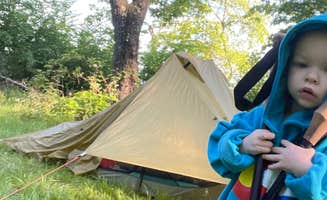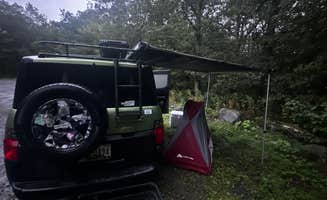Dispersed camping near Parryville, Pennsylvania concentrates around the Delaware Water Gap and Blue Mountain regions, with elevations ranging from 400 to 1,600 feet. The terrain combines oak-hickory forests with rocky outcroppings typical of the eastern Pennsylvania highlands. Weather conditions vary significantly by season, with summer temperatures averaging 75-85°F and winter lows frequently below freezing.
What to do
Hiking to viewpoints: At Bake Oven Knob, the trail to the overlook provides accessible terrain for day hikers and overnight campers. "The hike to the overlook is really lovely; short and rocky," notes Dani T., who frequently visits the area. The Blue Mountain ridge offers multiple connecting trails for longer excursions.
Overnight backpacking: The Appalachian Trail corridor near Parryville connects to numerous side trails and primitive camping areas. Backpackers seeking multi-day experiences can connect segments between established sites. Some areas restrict ground fires and require food storage in bear containers.
Wildlife observation: Spring and fall migrations bring diverse bird species through the region's ridgelines. Early mornings at trailheads like Thunder Swamp provide wildlife viewing opportunities. "Went down Saw Creek trail to a marsh," reports Jason R., highlighting potential wildlife viewing areas near water sources.
What campers like
Accessible overnight parking: Thunder Swamp Trailhead provides simple vehicle-based camping options. "It's a gravel parking lot. Plenty of shade. No one bothered me," reports Benjamin H. about his stay at the location. This makes it suitable for those seeking minimal setup requirements.
Hammock-friendly terrain: Tree density at most sites accommodates hammock camping setups. "Good trees for hammocking," notes Katharine T. about her experience at Appalachian Trail Designated Backpacker Campsite 2. Most dispersed sites have adequate spacing between suitable trees.
Rustic isolation: Primitive camping near Parryville offers genuine wilderness experiences without developed facilities. The absence of designated sites at some locations allows campers to select their own spots based on personal preferences for privacy and terrain.
What you should know
Limited water access: Plan to carry sufficient water supplies for your entire stay. "I gave the site only four stars because there's no water nearby," mentions Renee Z. about the Appalachian Trail campsite. The nearest reliable water sources may require significant hiking distance from camping locations.
Parking constraints: Vehicle-based camping requires advance planning for appropriate locations. Overnight parking is permitted at designated trailheads but prohibited at many roadside pullouts and day-use areas within state lands.
Bear safety protocols: Food storage requirements vary by location. Bear activity in the region necessitates proper precautions with all food items and scented products. Some designated sites provide bear boxes as Katharine T. notes: "Well maintained w bear boxes provided."
Tips for camping with families
Starter backpacking: The shorter trails near designated sites offer good introductions to backpacking for families. Sites with minimal hiking distance from parking areas allow children to experience rustic camping without extended hikes.
Educational opportunities: The Appalachian Trail corridor contains interpretive information about local ecology and trail history. Several access points feature informational kiosks suitable for teaching children about environmental stewardship.
Site selection: When camping with children, seek relatively flat terrain away from steep drop-offs. "We camped nearer to others but there are secluded spots too," notes Katharine T. at Appalachian Trail Designated Backpacker Campsite, indicating families can find suitable spots based on their comfort level with isolation.
Tips from RVers
Van camping options: Several areas accommodate van-based camping for self-contained vehicles. "I've overnighted in my van here a bunch, no problems," shares Dani T. about Bake Oven Knob. These locations typically have gravel or dirt parking surfaces without hookups.
Road access considerations: Access roads to most rustic camping near Parryville vary in quality and maintenance. Larger vehicles may face challenges with road width, surface conditions, and turning radius at smaller trailheads.
Resource management: With no hookups or facilities available, van and RV campers must plan for complete self-sufficiency. This includes carrying sufficient water, managing waste, and having adequate battery power or solar capabilities for extended stays.



